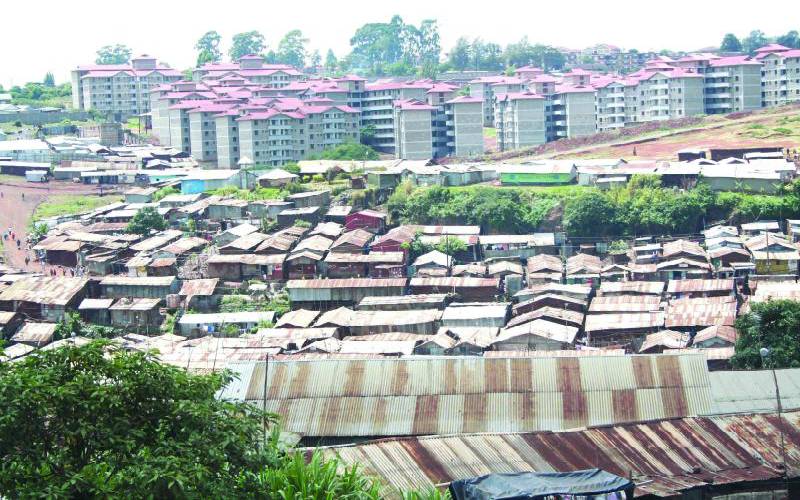 Nancy Achieng lives in Kibera on less than Sh200 a day. Money she earns by washing clothes in nearby Langata estates.
Nancy Achieng lives in Kibera on less than Sh200 a day. Money she earns by washing clothes in nearby Langata estates.
The mother of four lacks a constant supply of water and electricity and relies on illegal utility connections. She is aware of inherent dangers but with little means of survival, she is more concerned about her family’s next meal than how efficient or clean the lighting and cooking fuels are.
The poor health of her family and the long treks to school are constant reminders of how fickle life can be in a slum. Majority of the 200,000 residents of Kibera, and other informal settlements in the country can identify with Achieng’s lifestyle.
They cling to the hope that the government’s resolve to address the housing problem and improve slum infrastructure will come to fruition.
About three years ago, Achieng saw a few of her neighbours move into the newly minted high rise buildings within Kibera’s Soweto East.
These houses were constructed at the tail end of President Mwai Kibaki’s tenure. Now, the current government has an ambitious goal of adding to this stock by constructing 500,000 houses in the initial phase of the Affordable Housing Programme, a key pillar in President Uhuru Kenyatta Big Four Agenda.
While the efforts to increase housing stock are laudable, experts in urbanisation say the homes cannot exist in isolation to a sustainable city.
Last week, top urban experts, leading researchers, business and civil society leaders from United Kingdom met their counterparts in Kenya at a symposium to tackle the social-economic aspects of housing.
In addition, the more than 200 policymakers who met at Strathmore University under the banner ‘Healthy Cities: Affordable Housing and Sustainable Infrastructure’ sought to explore new innovations to scale up affordable housing and sustainable infrastructure.
“The UK will work with the Kenyan government to address the challenge of delivering affordable housing for all. To deliver on this policy priority, we need to leverage on research, technology and innovation,” said British High Commissioner to Kenya Nic Hailey.
In their view, housing is the basic element in delivering wider economic gains meant to uplift people like Achieng from the ever-tightening noose of urban poverty. The infrastructure around such housing, they noted, should go beyond providing a roof over one’s head.
“Building new houses is only part of the solution which also involves providing access to health and education services, safe public spaces and to the jobs and opportunities.
“We support policy-relevant research on issues ranging from healthcare access to embedding disaster risk management into urban development,” said Dr Jaideep Gupte, challenge leader for cities and sustainable infrastructure at Global Challenges Research Fund.
A key report from the symposium says affordable housing is best implemented as an integrated agenda to achieve improved health, affordable and essential services, equitable education and employment opportunities that reduce expensive and environmentally damaging transport.
According to the report, people in informal settlements have more acute needs that go beyond the provision of houses. These include lack of clean water, poor drainage, security and proper garbage disposal.
Stay informed. Subscribe to our newsletter
It is also in the informal areas where property rights and security of tenure are opaque. Reports indicate that less than 30 per cent of developing countries have some form of land registration. “Without these ancillary investments, housing alone can become a burden for residents who are forced to travel long distances to access services or forced to live in unhealthy or unsafe environments. Concentrating solely on providing serviced homes is likely to neglect the poorer majority,” it said.
Urban centres ill-equipped
At the centre of such lofty ideals is the realisation that Kenya’s urban centres are ill-equipped to handle the annual influx of migrants from rural areas. “By 2030, nearly half of Kenyans will be living in cities. With half of Kenya’s current population under 18 years, many young people are moving to urban areas in search of jobs, opportunities and more choices. Kenya’s growing urban population needs sustainable, resilient, affordable housing and getting this right is key to Kenya’s development,” said the report.
Globally, urban areas occupy two per cent of world’s land but house over 55 per cent of global population. In addition, 60 per cent of the area expected to be urban by 2030 is yet to be built. Such rapid urbanisation places more stress on existing infrastructure and amenities, creating more informal settlements.
“Affordable housing would need to counter barriers to inclusion and reverse the cycle of deprivation which can create an opening for violence and stigmatiSation,” adds the report. But as the experts pointed out, urbanisation should not just be seen as a risk but an opportunity to create fully sustainable societies.
In the meantime, people like Nancy Achieng who know little about such high level symposiums or what “sustainable urban infrastructure” is all about will continue to eke out their living in the hostile
 The Standard Group Plc is a
multi-media organization with investments in media platforms spanning newspaper
print operations, television, radio broadcasting, digital and online services. The
Standard Group is recognized as a leading multi-media house in Kenya with a key
influence in matters of national and international interest.
The Standard Group Plc is a
multi-media organization with investments in media platforms spanning newspaper
print operations, television, radio broadcasting, digital and online services. The
Standard Group is recognized as a leading multi-media house in Kenya with a key
influence in matters of national and international interest.
 The Standard Group Plc is a
multi-media organization with investments in media platforms spanning newspaper
print operations, television, radio broadcasting, digital and online services. The
Standard Group is recognized as a leading multi-media house in Kenya with a key
influence in matters of national and international interest.
The Standard Group Plc is a
multi-media organization with investments in media platforms spanning newspaper
print operations, television, radio broadcasting, digital and online services. The
Standard Group is recognized as a leading multi-media house in Kenya with a key
influence in matters of national and international interest.

 Nancy Achieng lives in Kibera on less than Sh200 a day. Money she earns by washing clothes in nearby Langata estates.
Nancy Achieng lives in Kibera on less than Sh200 a day. Money she earns by washing clothes in nearby Langata estates.







